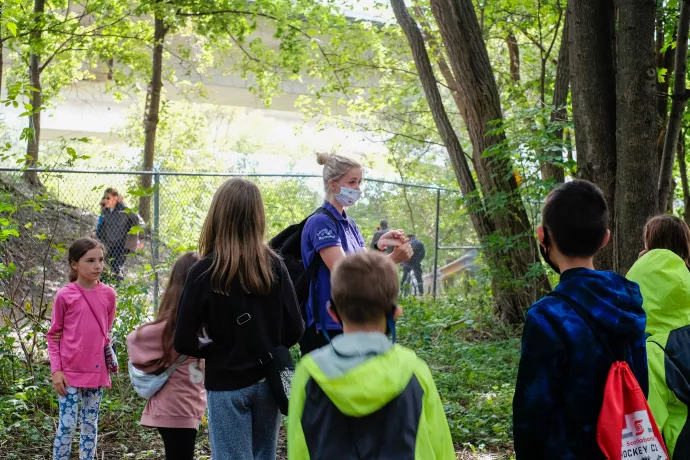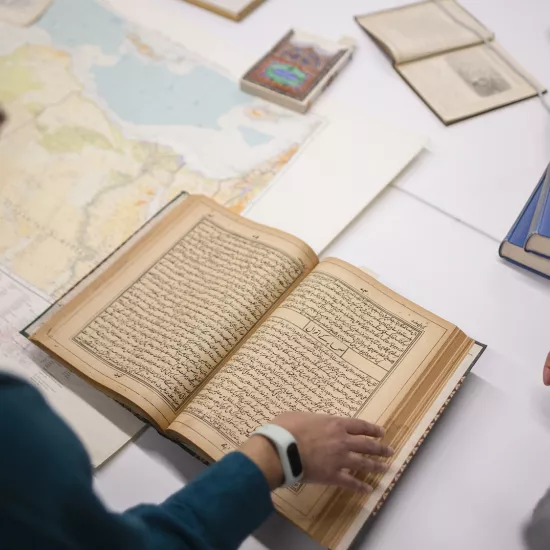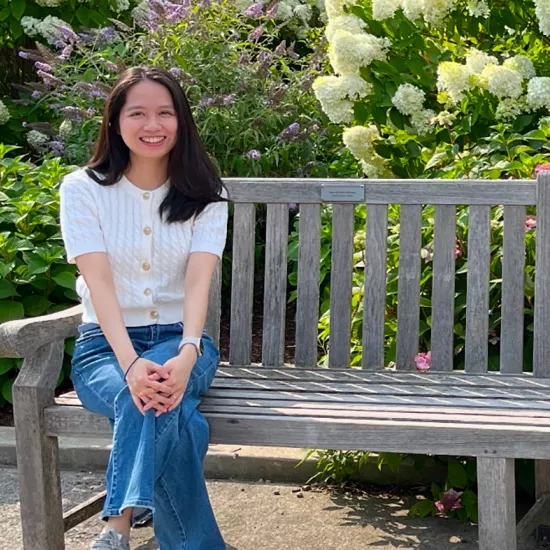Blackwood Gallery’s Lyfeboat prototype: a floating platform for community engagement on ecology

An experimental floating forest has launched in a little bay on the Mississauga eastern waterfront.
The raft-like structure is Lyfeboat prototype, a new artistic collaboration between University of Toronto Mississauga’s Blackwood Gallery and artist and playground designer Sean Procyk.
Visitors to the bay will see the pentagon-shaped pastel structure anchored just off-shore in at Lakefront Promenade Marina, which is home to red-eared grebes and mute swans and sits next to a bustling city splash pad and boardwalk. Lyfeboat protoype supports a canopy shading a container planted with black locust saplings, and the occasional water bird stopping to rest on the deck.
The project represents a return to the water’s edge for the Blackwood, which presented The Work of Wind: Air, Land, Sea in Mississauga’s Southdown industrial area in 2018. The 10-day contemporary art festival explored climate change, environmental crisis and resilience on industrial and natural sites located next to Lake Ontario.
Lyfeboat is also a return of sorts for Procyk, who has collaborated with the Blackwood in the past. The Hamilton-based artist, who works primarily with found, reclaimed and natural materials, creates site-specific installations and community workshops designed to bring participants together in creation and discussion. Previous works included an outdoor sauna and performance space for Toronto gallery 8-11 and a collaborative timber barn-raising for an artists’ residency project in Alberta.

In 2019, Procyk presented an an outdoor art program with the Blackwood which invited the public to build a pop-up presentation and learning space at the Riverwood Conservancy designed to be used for art and historical interpretative talks.
Lyfeboat prototype continues this work, using architectural and natural elements to explore overlapping themes of ecology and sustainability, Indigenous and colonial settler experiences, and notions about the basic elements of life in the universe.
Procyk drew upon his own Polish heritage for inspiration for the form of the structure. Long ago, timber harvested in the southern mountains was turned into massive rafts to be floated downriver to Poland’s port cities. “Sometimes whole families or communities would guide the rafts down the river — that’s how they made their money,” Procyk says.
The artist says Lyfeboat prototype incorporates his own questions about succession, nature, and giving back to the land. “I wondered if I could do something similar, like using a floating vessel to regenerate and eventually plant back into the landscape?”
Last fall, Procyk began growing trees for Lyfeboat prototype from seeds and root cuttings. He chose black locusts, which are common in the Mississauga region but are an introduced species considered to be invasive. The fast-growing durable wood has been used for colonial-settler activities like shipbuilding and fence posts, and Procyk’s playground structures. The Lyfeboat prototype planter uses a rudimentary capillary system to draw lake water up to the trees.
The meaning of “Lyfe”

Goldenrod, 2020. Hooked rug, wool on monk’s cloth, 22in x 30in. (Image courtesy Amanda White)
Procyk says the name for the work plays with different ideas about life, sustainability and understanding. He notes that the term “lifeboat” is used by space researchers in astrobiology. “It’s a discipline interested in what’s happening in the universe, and how to consider and define the idea of a living organism,” he says.
“While this project was in my head, I kept referring to it as a “lifeboat” but intentionally misspelling it,” he adds. “‘Lyfe’ is often used by younger generations to question the meaning of life or the reality they have been born into.”
“There’s a nice parallel between that and thinking about Lyfeboat prototype as a platform for artist talks and public programs leading to discussions that unpack or challenge ideas.”
Lyfeboat prototype will be the physical focus of the Blackwood Gallery’s parallel Nearshore Gatherings program, a five-part event public event series focused on environmental activism and stewardship. The events will feature on-site public talks by UTM researchers, including anthropology professor Sherry Fukuzawa, local artists, Indigenous knowledge keepers and members of youth and environmental stewardship programs, as well as a land-based family-friendly tree-planting initiative at the Riverwood Conservatory.
For the waterfront events, Lyfeboat prototype will be towed to shore, allowing participants to board the wheelchair-accessible platform and explore the work up close.
“We are always trying to connect with communities in Mississauga and Peel and beyond the campus,” says Blackwood coordinator and Nearshore Gatherings curator Fraser McCallum, who notes the support of community partners, including the City of Mississauga, Lakeview Village, Dock Edge, Ontario Arts Council, U of T's School of Cities, Manulife, MBNA, and TD Insurance.
“Nearshore Gatherings brings together a cross-section of different communities and subsets of people who are looking at ecology and environmentalism in the region.”

McCallum notes that the area falls under the provisions in Treaty 13-A and is the traditional territory of the Mississaugas of the Credit First Nation. “The waterways were trading routes and points of connection between Indigenous communities,” he says. “The water is part of an active water claim in this region. Thinking about the interactions between the water and the land provides a new way to consider Indigenous sovereignty.”
“It’s easy to forget how close we are to these incredible waterways,” McCallum says. “We hope to rekindle or rebuild people’s connections to the waterways of Mississauga and Peel region. It’s vital that they are protected and conserved, and also that Indigenous communities continue to have access here and broader access to clean water."
For his part, Procyk is excited to see how Lyfeboat prototype is received. “What people take away will be based on the experiences they bring,” he says.
“During the installation, we had conversations with people passing by who each looked at it in a different way. Some thought we were building a platform for birds to nest on, which I thought was really beautiful. Others thought we were building a dock to fish from, because that’s a common activity that takes place there.”
“Visitors will see Lake Ontario, the bay and the shoreline, where there is a wastewater treatment plant and a marina with leisure crafts and people fishing,” Procyk says. “There are living organisms, like birds and beavers, bugs and fish. These different realities and ecosystems co-existing, and within that landscape, there’s the Lyfeboat prototype.”
“The public domain presents different interactions,” he says. “Everyone will have their own interpretation, and not everyone will expect a work of art. I have a feeling it will morph and shift, even in terms of how I interpret it.”
Read more:



